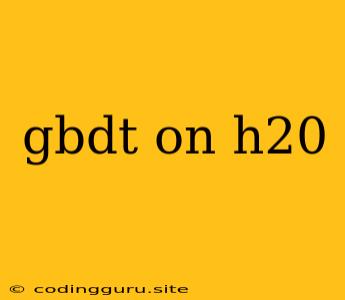Dive Deep into Gradient Boosting Machines (GBDT) on H2O
Gradient Boosting Machines (GBDT) are a powerful machine learning algorithm that has gained immense popularity for its versatility and exceptional performance across a wide range of tasks. GBDT is an ensemble learning method that combines multiple weak learners, typically decision trees, to create a strong predictive model. H2O, a popular open-source machine learning platform, provides a robust and efficient implementation of GBDT, making it an ideal choice for data scientists and machine learning practitioners.
What is GBDT?
GBDT is based on the concept of boosting, where a sequence of weak learners are trained iteratively. Each subsequent learner focuses on correcting the errors made by the previous learners. The final prediction is obtained by aggregating the predictions from all the individual learners.
How does GBDT work on H2O?
H2O's GBDT implementation utilizes a distributed, parallel execution framework to handle large datasets efficiently. It offers a wide range of hyperparameters that allow you to fine-tune the algorithm's performance for your specific problem. These hyperparameters include:
- Number of trees: Controls the number of weak learners in the ensemble.
- Learning rate: Determines the contribution of each individual tree to the final prediction.
- Max depth: Limits the depth of each decision tree, helping to prevent overfitting.
- Min rows: Sets the minimum number of observations required to split a node in a tree.
- Column sampling: Controls the fraction of features used for each tree, which can help to reduce overfitting and improve generalization performance.
Why Choose GBDT on H2O?
H2O's GBDT implementation offers several advantages, making it a preferred choice for many machine learning applications:
- Scalability: H2O's distributed architecture allows it to efficiently handle large datasets that wouldn't be feasible for traditional single-machine implementations.
- Performance: GBDT on H2O consistently achieves high accuracy across a wide range of tasks, including classification, regression, and ranking.
- Flexibility: The algorithm offers a range of hyperparameters that allow you to customize the model's behavior for specific problem settings.
- Ease of use: H2O provides a user-friendly API and a rich ecosystem of tools that simplify the process of building and deploying GBDT models.
Use Cases for GBDT on H2O
GBDT on H2O finds applications in various domains, including:
- Predictive modeling: Predicting customer churn, fraudulent transactions, and product demand.
- Recommendation systems: Recommending products, movies, and music to users based on their preferences.
- Risk assessment: Evaluating creditworthiness and insurance risk.
- Natural language processing: Sentiment analysis and text classification.
Tips for Using GBDT on H2O
Here are some tips for using GBDT effectively on H2O:
- Data preprocessing: Ensure your data is clean, well-formatted, and appropriately scaled before feeding it into the model.
- Hyperparameter tuning: Experiment with different hyperparameter values to find the optimal configuration for your problem.
- Cross-validation: Use cross-validation techniques to evaluate the model's performance and prevent overfitting.
- Feature engineering: Create new features that capture relevant information and improve the model's predictive power.
- Feature importance: Use feature importance analysis to identify the most influential features in the model.
Example of Using GBDT on H2O
import h2o
from h2o.estimators import H2OGradientBoostingEstimator
# Initialize H2O
h2o.init()
# Load the dataset
data = h2o.import_file("path/to/dataset.csv")
# Split the data into training and testing sets
train, test = data.split_frame(ratios=[0.8])
# Create a GBDT model
model = H2OGradientBoostingEstimator(ntrees=100, learn_rate=0.1)
# Train the model
model.train(x="independent_variables", y="dependent_variable", training_frame=train)
# Predict on the test set
predictions = model.predict(test_frame=test)
# Evaluate the model's performance
performance = model.model_performance(test_frame=test)
# Print the performance metrics
print(performance)
Conclusion
GBDT on H2O is a powerful and versatile machine learning algorithm that offers exceptional performance across a wide range of tasks. By utilizing H2O's distributed architecture and rich feature set, you can efficiently build and deploy GBDT models that can handle large datasets and achieve high accuracy. Whether you're tackling a classification, regression, or ranking problem, GBDT on H2O is a valuable tool for any data scientist's arsenal.
